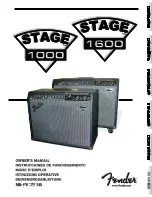
9
Setting Up and Using the Servo Amplifier
Setting up your Servo Amplifier is a simple procedure which takes only a few
minutes:
1. Remove all packing materials (save them in case of need for future service)
and decide where the amplifier is to be physically placed—it can be used free-
standing or mounted in a standard 19" rack, requiring only two rack spaces. Be
careful when handling the Servo Amplifier—the rear heat sink fins have sharp
edges. When installed, make sure that the rear heat sink fins are unobstructed
and that there is good ventilation around the entire unit. Before rack-mounting,
use a Philips screwdriver to remove the bottom panel rubber feet. If your rack
contains multiple amplifiers, we recommend that you avoid potential overheating
problems by using spacer panels to ensure that the amps are not directly on top
of one another. If you are using a Servo-550, set the Bridged Mono / Stereo
switch on the rear panel as desired (see Appendix E for more information).
2. Begin by making the speaker connections, using either the binding post,
push-spring or 1/4" output connectors on the rear panel. It is never a good idea
to power up any amplifier that is not connected to loudspeakers. Any
loudspeakers with a minimum impedance load of 4 ohms (that is, 4 ohms or
greater) can be used. See Appendix A for a partial listing of compatible nearfield
monitors.
3. Next, make the signal input connections, using the electronically balanced
1/4" input connectors on the rear panel (or, in the Servo-260 and Servo-170, the
unbalanced RCA-type connectors). On the front panel, turn both the left and
right Channel input controls fully counterclockwise (to their “
∞
” setting).
4. Finally, connect the supplied 3-pin “IEC” plug to the rear panel AC connector
and plug the other end into any grounded AC socket. Because of the relay
protection circuitry built into the Servo Amplifier, you can even plug it into the
same power strip that other audio devices (such as a mixing console) are
connected to. You can then turn on all devices at once with the single power
strip on-off switch, with no danger of damaging connected speakers by
generating “thumps.”
5. Press the front panel Power switch in order to turn on the Servo Amplifier.
The Protection light will go on for approximately five seconds, and then switch off
(you’ll hear a click when it does).
6. Apply an input signal to the amplifier at or about +4 dBu (if sending signal
from a mixer, drive the output meters at approximately 0 vu). While the input
signal is present, slowly raise the Channel input controls until the desired sound
level is achieved. For best signal-to-noise ratio, the Servo Amplifier should
normally be run with the Channel input controls at or near maximum (fully
clockwise, at the “MAX” position); if you are using a mixer that has a master
output level control (sometimes called “control room level”), use it to attenuate
the signal as necessary to achieve the desired speaker level. In normal
operation, the Clip lights should not light at all; if they do, lower the level of the
incoming signal so that they do not light at all (clipping not only sounds awful, it
can also damage speakers). In normal operation, the Idle lights will flash
occasionally (they go on whenever incoming signal is present).
If you encounter difficulty with any aspect of setting up or using your Servo
Amplifier, you can call Samson Technical Support (1-800-372-6766) between
9 AM and 5 PM EST.
IMPORTANT NOTE: Only the Servo-550 is designed to permit mono
bridging; any attempt to do so with the Servo-260 or Servo-170 models
may cause damage to the unit and will void your warranty.
RIGHT
LEFT
+RIGHT
LEFT+
GROUND
OUTPUT 120W/4
Ω
RIGHT
LEFT
GROUND
+RIGHT
LEFT +
GROUND
PROTECTION
POWER
CLIP
IDLE
BRIDGED
MONO
STEREO
RIGHT
LEFT
INPUTS
(BALANCED 10K
Ω
/0dBM)
(UNBALANCED 10K
Ω
/0dBM)
R
L
RIGHT
LEFT
INPUTS
(BALANCED
10K
Ω
/0dBm0)
Servo-550 Bridged Mono / Stereo switch
Servo-260 and 170 output connectors
Servo-550 output connectors
Servo-260 and 170
input connectors
Servo-550
input connectors


































